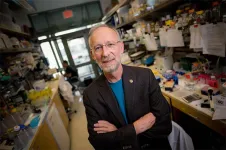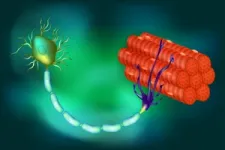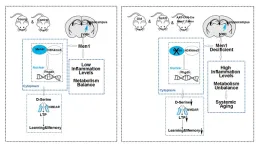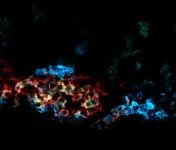(Press-News.org) In virtually all persons with amyotrophic lateral sclerosis (ALS) and in up to half of all cases of Alzheimer’s disease (AD) and frontotemporal dementia, a protein called TDP-43 is lost from its normal location in the nucleus of the cell. In turn, this triggers the loss of stathmin-2, a protein crucial to regeneration of neurons and the maintenance of their connections to muscle fibers, essential to contraction and movement.
Writing in the March 16, 2023 issue of Science, a team of scientists, led by senior study author Don Cleveland, PhD, Distinguished Professor of Medicine, Neurosciences and Cellular and Molecular Medicine at University of California San Diego School of Medicine, with colleagues and elsewhere, demonstrate that stathmin-2 loss can be rescued using designer DNA drugs that restore normal processing of protein-encoding RNA.
“With mouse models we engineered to misprocess their stathmin-2 encoding RNAs, like in these human diseases, we show that administration of one of these designer DNA drugs into the fluid that surrounds the brain and spinal cord restores normal stathmin-2 levels throughout the nervous system,” Cleveland said.
Cleveland is broadly credited with developing the concept of designer DNA drugs, which act to either turn on or turn off genes associated with many degenerative diseases of the aging human nervous system, including ALS, AD, Huntington’s disease and cancer.
Several designer DNA drugs are currently in clinical trials for multiple diseases. One such drug has been approved to treat a childhood neurodegenerative disease called spinal muscular atrophy.
The new study builds upon ongoing research by Cleveland and others regarding the role and loss of TDP-43, a protein associated with ALS, AD and other neurodegenerative disorders. In ALS, TDP-43 loss impacts the motor neurons that innervate and trigger contraction of skeletal muscles, causing them to degenerate, eventually resulting in paralysis.
“In almost all of instances of ALS, there is aggregation of TDP-43, a protein that functions in maturation of the RNA intermediates that encode many proteins. Reduced TDP-43 activity causes misassembly of the RNA-encoding stathmin-2, a protein required for maintenance of the connection of motor neurons to muscle,” said Cleveland.
“Without stathmin-2, motor neurons disconnect from muscle, driving paralysis that is characteristic of ALS. What we have now found is that we can mimic TDP-43 function with a designer DNA drug, thereby restoring correct stathmin-2 RNA and protein level in the mammalian nervous system.”
Specifically, the researchers edited genes in mice to contain human STMN2 gene sequences and then injected antisense oligonucleotides — small bits of DNA or RNA that can bind to specific RNA molecules, blocking their ability to make a protein or changing how their final RNAs are assembled — into cerebral spinal fluid. The injections corrected STMN2 pre-mRNA misprocessing and restored stathmin-2 protein expression fully independent of TDP-43 function.
“Our findings lay the foundation for a clinical trial to delay paralysis in ALS by maintaining stathmin-2 protein levels in patients using our designer DNA drug,” Cleveland said.
Co-authors include: Michael W. Baughn, Jone López-Erauskin, Melinda S. Beccari, Roy Maimon, Sonia Vazquez-Sanchez, Jonathan W. Artates and Eitan Acks, all at Ludwig Institute for Cancer Research-UC San Diego and UC San Diego; Ze’ev Melamed, Ludwig Institute for Cancer Research-UC San Diego, UC San Diego, and The Hebrew University of Jerusalem; Karen Ling, Paayman Jafar-nejad, Frank Rigo and C. Frank Bennett, all at Ionis Pharmaceuticals; Aamir Zuberi, Maximilliano Presa, Elena Gonzalo-Gil and Cathleen Lutz, all at The Jackson Laboratory; Som Chaturvedi, Mariana Bravo-Hernández, Vanessa Taupin and Stephen Moore, all at UC San Diego; L. Sandra Ndayambaje and Ana R. Agra de Almeida Quadros, Harvard Medical School; Clotilde Lagier-Tourenne, Harvard University and Broad Institute of Harvard University and Massachusetts Institute of Technology.
# # #
END
DNA treatment could delay paralysis that strikes nearly all patients with ALS
In both mouse and human motor neuron studies, a DNA designer drug restored levels of a protein necessary to keep motor neurons functioning, returning activity impaired in amyotrophic lateral sclerosis; findings could lead to clinical trials.
2023-03-16
ELSE PRESS RELEASES FROM THIS DATE:
Loss of Menin helps drive the aging process, and dietary supplement can reverse it in mice
2023-03-16
Decline in the hypothalamic Menin may play a key role in aging, according to a new study publishing March 16th in the open access journal PLOS Biology by Lige Leng of Xiamen University, Xiamen, China, and colleagues. The findings reveal a previously unknown driver of physiological aging, and suggest that supplementation with a simple amino acid may mitigate some age-related changes.
The hypothalamus has been recognized as a key mediator of physiological aging, through an increase in the process ...
Dana-Farber researchers chart a course for understanding, preventing, and treating young-onset colorectal cancer
2023-03-16
Colorectal cancer among young people is increasing globally and rapidly. Experts expect it to become the leading cause of cancer death in individuals aged 20-49 in the U.S. by the year 2030.
Yet no one is certain why this disease is suddenly affecting so many young people. In a new paper published in Science, Dana-Farber Cancer Institute researchers outline the complexities of the disease and the research needed to map out a path toward understanding it.
“The rising incidence of young-onset colorectal cancer is extremely concerning, and it is urgent that the scientific community comes together to better understand the underlying ...
Hidden signals play a vital role in evolution of warning coloration in amphibians
2023-03-16
New findings help answer a particularly vexing evolutionary question: how do species that use bright coloration to keep predators away survive long enough for this warning signal coloration to evolve, before predators who can better spot them through their colors learn to avoid them? A study comparing a series of models points to warning color signaling, or aposematism, likely appearing through intermediate steps where coloration is only visible when an organism is fleeing or intentionally displaying a hidden feature. Evolutionary selection to avoid being eaten by predators has driven considerable variation in the diversity of animal ...
Common gut bacterium exploits Rho factor phase separation to colonize the mammalian gut
2023-03-16
The common commensal gut bacterium Bacteroides thetaiotaomicron uses phase separation of the transcription termination factor Rho to colonize and thrive in the mammalian gut, according to a new study in mice. The findings suggest that phase separation may also be vital for other important gut microbes and relevant for novel microbiome-based clinical applications. The gut microbiota plays a critical role in human health. Manipulating gut commensal communities could provide promising therapeutic pathways for treating a host of diseases. However, this goal requires understanding mechanisms that enable ...
Lessons from China’s coal strategy can inform environmental cooperation
2023-03-16
In 2021, China unilaterally announced that it would stop building new coal-fueled power plants overseas, which was lauded as an important climate milestone. However, this decision stands in contrast to the nation’s continued support for the domestic use of coal plants. In a Policy Forum, Christoph Nedopil discusses this dichotomy and provides new insights into how these decisions were made. According to Nedopil, the findings could inform efforts to improve environmental cooperation with China. China has become the world’s greatest source of greenhouse gas emissions, and its international influence through trade, ...
Nano cut-and-sew: New method for chemically tailoring layered nanomaterials could open pathways to designing 2D materials on demand
2023-03-16
A new process that lets scientists chemically cut apart and stitch together nanoscopic layers of two-dimensional materials — like a tailor altering a suit — could be just the tool for designing the technology of a sustainable energy future. Researchers from Drexel University, China and Sweden, have developed a method for structurally splitting, editing and reconstituting layered materials, called MAX phases and MXenes, with the potential of producing new materials with very unusual compositions and exceptional properties.
A “chemical scissor” is a chemical designed to react with a specific compound to break ...
Fomepizole helps overcome antibiotic-resistant pneumonia in mice
2023-03-16
Pneumococcal disease leads to over three million hospitalizations and hundreds of thousands of deaths annually. A study publishing March 16th in the open access journal PLOS Biology by Carlos J. Orihuela at the University of Alabama at Birmingham, Alabama, United States, and colleagues suggests that the FDA-approved drug Fomepizole may reduce disease severity in the lungs of mice with some forms of bacterial pneumonia and enhance the efficacy of the antibiotic erythromycin as well.
Streptococcus pneumoniae is the leading cause of community-acquired ...
Losing key type of pancreatic cell may contribute to diabetes
2023-03-16
Losing Key Type of Pancreatic Cell May Contribute to Diabetes
Multiple types of beta cells produce insulin in the pancreas, helping to balance blood sugar levels. Losing a particularly productive type of beta cell may contribute to the development of diabetes, according to a new study by Weill Cornell Medicine investigators.
In the study, published March 16 in Nature Cell Biology, Dr. James Lo, associate professor of medicine at Weill Cornell Medicine, and colleagues measured gene expression in individual beta cells collected from mice to determine how many different types of beta cells exist in the pancreas. The team discovered four distinct beta cell types, including one that stood out. ...
Spin-off: 12 million euros for a novel gene editing platform
2023-03-16
The TU Dresden Spin-off Seamless Therapeutics Launches with $12.5M Seed Financing to Advance Transformative Gene Editing Platform Based on Programmable Precision Designer Recombinases in Dresden
Seed round co-led by Wellington Partners and Forbion, with additional non-dilutive financial support from the BMBF (GO-Bio funding) enables maturation of the proprietary platform and pipeline towards first clinical evaluation
Seamless Therapeutics, a Dresden based start-up of the Technische Universität Dresden, today announced a $12.5 million (€11.8M) seed financing round which will accelerate further development ...
Paxlovid associated with lower risk of hospital admission
2023-03-16
PASADENA, Calif. — A Kaiser Permanente study confirms the benefit of nirmatrelvir-ritonavir, also known as Paxlovid, as an early-stage treatment to prevent hospitalization for people with mild to moderate COVID-19, regardless of prior immunity or age. The study was published March 15, 2023, in Lancet ID.
“Among Kaiser Permanente members in Southern California who tested positive for coronavirus infection, receiving Paxlovid within 5 days of the start of COVID-19 symptoms was associated with substantial reductions in the risk of hospital admission or death,” said Sara Tartof, PhD, the senior author of the study and an epidemiologist with the Kaiser ...
LAST 30 PRESS RELEASES:
UVA’s Jundong Li wins ICDM’S 2025 Tao Li Award for data mining, machine learning
UVA’s low-power, high-performance computer power player Mircea Stan earns National Academy of Inventors fellowship
Not playing by the rules: USU researcher explores filamentous algae dynamics in rivers
Do our body clocks influence our risk of dementia?
Anthropologists offer new evidence of bipedalism in long-debated fossil discovery
Safer receipt paper from wood
Dosage-sensitive genes suggest no whole-genome duplications in ancestral angiosperm
First ancient human herpesvirus genomes document their deep history with humans
Why Some Bacteria Survive Antibiotics and How to Stop Them - New study reveals that bacteria can survive antibiotic treatment through two fundamentally different “shutdown modes”
UCLA study links scar healing to dangerous placenta condition
CHANGE-seq-BE finds off-target changes in the genome from base editors
The Journal of Nuclear Medicine Ahead-of-Print Tip Sheet: January 2, 2026
Delayed or absent first dose of measles, mumps, and rubella vaccination
Trends in US preterm birth rates by household income and race and ethnicity
Study identifies potential biomarker linked to progression and brain inflammation in multiple sclerosis
Many mothers in Norway do not show up for postnatal check-ups
Researchers want to find out why quick clay is so unstable
Superradiant spins show teamwork at the quantum scale
Cleveland Clinic Research links tumor bacteria to immunotherapy resistance in head and neck cancer
First Editorial of 2026: Resisting AI slop
Joint ground- and space-based observations reveal Saturn-mass rogue planet
Inheritable genetic variant offers protection against blood cancer risk and progression
Pigs settled Pacific islands alongside early human voyagers
A Coral reef’s daily pulse reshapes microbes in surrounding waters
EAST Tokamak experiments exceed plasma density limit, offering new approach to fusion ignition
Groundbreaking discovery reveals Africa’s oldest cremation pyre and complex ritual practices
First breathing ‘lung-on-chip’ developed using genetically identical cells
How people moved pigs across the Pacific
Interaction of climate change and human activity and its impact on plant diversity in Qinghai-Tibet plateau
From addressing uncertainty to national strategy: an interpretation of Professor Lim Siong Guan’s views
[Press-News.org] DNA treatment could delay paralysis that strikes nearly all patients with ALSIn both mouse and human motor neuron studies, a DNA designer drug restored levels of a protein necessary to keep motor neurons functioning, returning activity impaired in amyotrophic lateral sclerosis; findings could lead to clinical trials.




